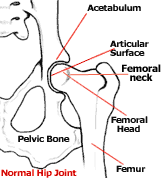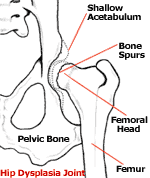HIP AND ELBOW DYSPLASIA IN LABRADORS


Introduction - What is it?
Hip Dysplasia is a genetic disease that affects the hip joints of dogs. Dysplasia literally means abnormal, so hip dysplasia translates as abnormal formation of the hip joint. Despite years of research and the combined effort of the Orthopedic Foundation for Animals and responsible dog breeders, it has been impossible to eliminate hip dysplasia from Labradors.
Hip dysplasia can be seen in dogs as young as five or six months of age. In others, symptoms do not develop until after the dog has matured.
Development of the disease
Dogs with a genetic predisposition for hip dysplasia are born with anatomically normal hips. However, as the dog grows, an abnormal maturation of the hip joint structure occurs. There is an unequal growth between the skeletal and muscular components. The bone literally grows too fast for the muscle mass and the supporting structures. This problem causes varying degrees of looseness in the joint. As the dog bears weight on the rear limbs, the head of the femur bone rubs against the cavity at the base of the hipbone (acetabulum). After continuous rubbing, damage occurs to the joint cartilage. The dog can then develop degenerative joint disease, pain, and lameness.
The degree to which CHD (canine hip dysplasia) is manifested in a particular dog depends on the degree of the animal's genetic predisposition, and the influence of a variety of environmental stresses. The greatest incidence of CHD occurs in the most rapidly growing breeds of dogs.
Hip Scoring.
At around 12 months of age, when the dog’s skeleton has fully developed, an x-ray is taken of the dog’s pelvis area. This x-ray is then sent from the vet to the AVA (Australian Veterinary Association) they will measure and score this x-ray with each hip of the two hips scoring between 0 (lowest) and 53 (highest). So when both hips are scored the total that dog achieves will be between a TOTAL of 0 and 106 (2 x 53).
Currently the breed average for a total of both hips sits at around 12.4 for Labradors. (Its different for each breed) So dogs around or under this score have average or better than average hips. The score will be shown as two numbers, left hip/right hip - so, something like 5/4 (total of 9 is good) or maybe 13/13 (total of 26 is poor).
Elbow Scoring
The scoring of the elbows is usually done at the same time as the hip x-rays. A set of x-rays of each of the dogs elbows are taken under general anesthetic. These x-rays are sent, again, to the AVA or DR B Wyburn in WA and scored. Because the joint is different to the hip it is scored differently. Elbows are each scored only from 0 - 3 (0 being excellent, 3 being very badly affected with problems). The small range of scores available mean that really, only dogs with no more then 1/1 score on each elbow should be bred from.
In summary, it is the parents of the litter who are scored and not the puppies. Only dogs that you intend to breed from are typically hip and elbow scored, it is not necessary to xray and score pet puppies that are not being bred from. Hip and elbow scoring is done once in a dog’s life only and these scores remain with him for the rest of his life.
Prevention
No guarantee can be given when breeding hip dysplasia free dogs radiographically that their offspring will not develop the disease. A dog can be hip dysplasia free on a radiograph, yet still carry the genetic predisposition to this disease that may be transmitted to its offspring.
Hip dysplasia has four major causes:
- genetics
- diet
- over feeding
- too much exercise at a young age
The environment plays a large part in whether or not a dog will suffer from hip dysplasia. Nutrition also has a contributing factor. Puppies should be kept lean and NOT fat. Obviously a puppy which is carrying round too much weight will exacerbate any degeneration of the joint.
Research has also shown that giving a diet too high in protein and calcium also exacerbates the condition. Rapid growth in a young puppy also contributes, and, in most cases, the rapid growth rate is directly related to feeding a high calorie diet to puppies. Over suplementation of calcium has likewise been shown to be a major factor in the development of skeletal disease in puppies.
Exercise is the other main contribution. Many people over-exercise young puppies, or give them the wrong type of exercise. The wrong type of exercise can include forced running for any distance and too much exercise on tarmac or other hard surfaces. Up to at least seven months of age, exercise on hard surfaces should be kept at a minimum. Correct exercise for puppies includes running and playing in the garden or in a park, although games that involve jumping and very rough play should be avoided, and your puppy should be allowed to rest as soon as he has had enough and must not "over-do it”. Swimming is an excellent form of exercise which builds up the muscles without putting stress on the joints.
